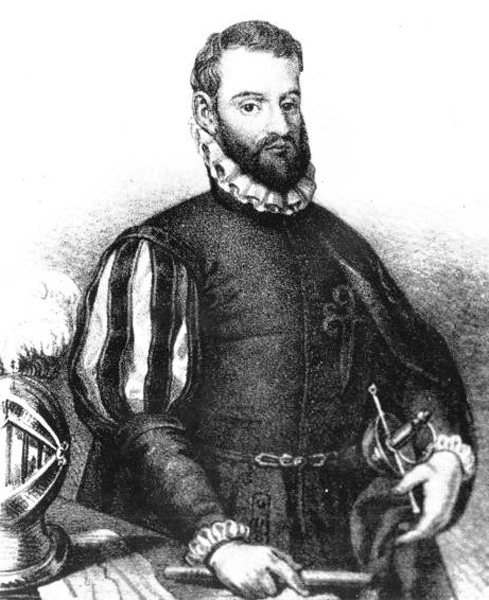
Pedro Menéndez de Avilés and His Galleon (15) |
 |
|---|
Source: Google Images. Photos by WTL© (2015). Image: This is the most frequently displayed image of Menéndez de Avilés. Comments: Notice the elements in this image that automatically tell the viewer about the man. On the left is his knight's jousting helmet (actual jousting, though mostly for ceremony and sport, was still done in 16th century Spain); in his right hand is a vara de mando (wand symbolizing command); on his left side with his left hand gently draped over it is his gentleman's fencing épée. On the left brest of his doublet is an embroidered cross of the very prestigious honorary society of the (knightly) Order of Santiago; and his collar is the standard dress collar of a nobleman. Pedro Menéndez de Avilés is considered by the citizens of Avilés, Spain, to be one of their most illustrious historical figures. From an early age he was a skilled marine pilot and sailor. From 1556 on he was promoted to the rank of admiral (Capitán general de la Armada), and he was a member of the prestigious knightly (chivalric) Order of Santiago. According to Justo Ureña y Hevia, chronicler of Avilés, Menéndez de Avilés was "an extraordinary seaman, an intelligent and brave soldier, a sensible and generous governor, a skillful diplomat, a peacemaker, a traditional devout Spanish Christian ... a wise man, a veritable Renaissance figure of his age ... fond of family, honest, noble and truthful..." (St. Augustine, Florida; San Agustín, Florida; Avilés, Spain; Avilés, España. Avilés, Spain: 2001, n.p Copyright © 2001, Foto Angelín, S.C.).Menéndez spent his whole active career in the Spanish Nave. One of his main motivations for leading an colonial expedition to La Florida is his strong desire to search for his son who had been shipwrecked in Florida in 1561. However, after the Protestant (and military) French settlement of Fort Caroline in 1564 on the river in what subsequently would become Jacksonville, Florida, he was promoted to the rank of Adelantado and ordered to assert Spain's physical presence on the peninsula. Hence, the founding of San Agustín in 1565. To accomplish this move against the French he and his soldiers massacred the French Huguenots (i.e., Protestants) at Fort Caroline and at Matanzas inlet, where Fort Matanzas has stood (reconstructed) since the 18th century. At St. Augustine, Menéndez set up a the basis of a typical Spanish colonial town with church, government buildings, town plaza, and fortifications. He returned to Spain in 1567, when he was appointed governor of Cuba. He returned with his wife and family to La Florida for the last time in 1571 with 650 colonists for the outpost in present-day South Carolina at Santa Elena. Menéndez returned to Spain in 1574, and, that year, he died at Santander. Humanities Question: (1) What is your summary view of this first founder of the first colonial settlement of the Spanish Empire in North America? |
|---|
 |